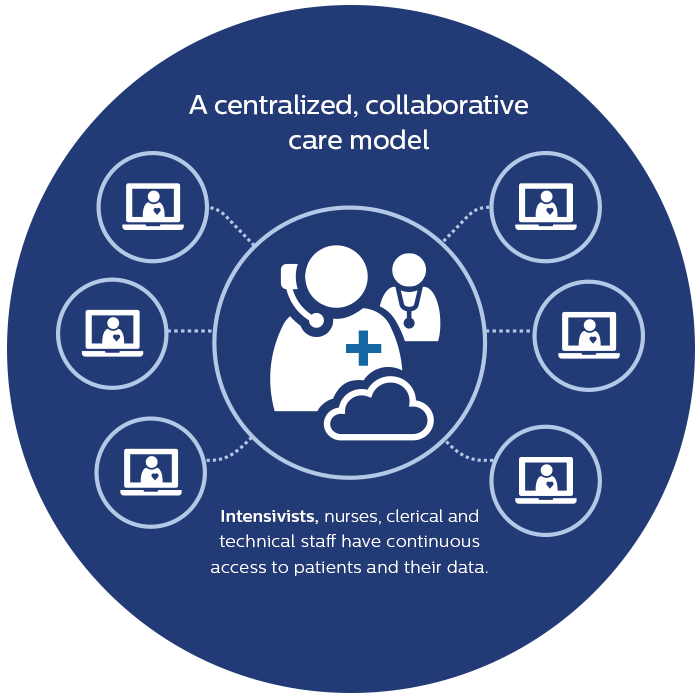What is the value of a
What is the value of a
What is tele-ICU? In its simplest form, a tele-ICU enables off-site clinicians to interact with bedside staff to consult on patient care. One centralized care team can manage a large number of geographically dispersed ICU locations to exchange health information electronically, in real time. A tele-ICU, like Philips eICU, is a supplement – not a replacement – to the bedside team, offering support to increasingly scarce clinical resources.
How Tele-ICU works: Tele-ICU programs concentrate clinical resources in remote care centers (a central monitoring facility) and extends those resources to the bedside via technology, independent of the care center or hospital’s location. Using A/V conferencing and a real-time data-stream of patient information from multiple interfaces, a physician working from a care center in New York City can rapidly care for a patient in Seattle, day or night. This connectivity enables an already engaged intensivist to promptly intervene and consistently provide care aligned with best-practices.
Calculating the value: Users are finding that tele -ICU not only serves a critical role in the effective regional management of ICUs, but positively impacts the healthcare system as a whole. Having a centralized remote patient monitoring center provides the ability to consolidate and standardize care, reduce transfers while maximizing bed utilization, and support onsite staff. This reduces costs while enhancing revenues, patient flow, and capacity management across the system.
Tele-ICU has been a vehicle that, through continuous communication, has enhanced and improved clinical outcomes. This program has transformed critical care delivery across our health system.”
—Kathy Johnson, RN, MHA
System Director, TeleHealth Operations, Presence Health
The right technology at the right time
A two-part challenge:

Intensive care units are a critical component of healthcare in the United States. They treat roughly 6 million of the sickest and oldest patients each year.16 Demand for critical care will grow as the population ages and the incidence of chronic disease increases, leading to ICU capacity constraints.
Intensivist demand*

Practicing intensivists
Intensivists needed

Because of the limited number of intensivists and the cost to attract and retain them, many hospitals find it difficult – or impossible – to staff their ICUs with intensivists 24-7. This problem is growing, as the supply of intensivists is projected to meet only 22% of the demand by 2020.1 In fact, The Leapfrog Group found that only 47% of hospitals surveyed have the recommended intensivist coverage2. Today’s reality is sobering. In the United States:




A solution
By leveraging tele-ICU capabilities, hospitals can make optimal use of their existing critical care resources, instead of adding additional resources.
In fact, the whole concept of the tele-ICU was born of the need to maximize resources and to prepare for the increase in ICU usage. Numerous studies demonstrate both the clinical and financial benefits of tele-ICU, and the continuous stream of patient data captured by tele-ICU programs can enable health systems to take a more evidence-based approach to population health.
Are tele-ICUs really cost effective?
A 2017 study in the journal CHEST took one of the broadest looks yet at the efficacy of the tele-ICU model, examining more than 51,000 patients across seven adult ICUs.14 While tele-ICUs have previously been associated with improving mortality rates and length of stay, this study is the first to address the financial outcomes in depth.
The results show: • An ICU managed by a tele-ICU improved case volume by 21% over traditional models. • A centralized tele-ICU model improved contribution margins by 376% ($37.7 million compared to $7.9 million) due to increased case volume, shorter lengths of stay and higher case revenue relative to direct costs. • A tele-ICU, when co-located with a logistical center (to improve bed utilization), improved case volume 38% over traditional models. • A tele-ICU with added logistical center and quality care standardization improved contribution margins by 665% ($60.6 million compared to $7.9 million). • This care delivery model allowed recovery of the initial capital costs of the ICU telemedicine program in less than 3 months.
The ability of tele-ICU programs to increase case volume and access to high- quality critical care while improving margins suggests a strong financial argument for wider adoption of ICU telemedicine.”
—Craig M. Lilly, MD
Current ICUs

Future tele-ICUs


5.7M patients admitted to the ICU annually9

20% reduction in mortality rates11

35% shortfall predicted in intensivists by 20201

30% reduction in length-of-stay11

15% increase in ICU bed growth at an average cost of $2M per bed10, 3

37% reduction in patients requiring transfer12

5.7M patients admitted to the ICU annually9

35% shortfall predicted in intensivists by 20201

15% increase in ICU bed growth at an average cost of $2M per bed10, 3

20% reduction in mortality rates11

30% reduction in length-of-stay11

37% reduction in patients requiring transfer12
Peer reviewed
Centralized or Decentralized ICU
In a decentralized tele-ICU model: One or more physicians and/or nurses have access to the ICU patient from multiple sites. There is no defined remote ICU structure. The model provides as-needed coverage. In a decentralized tele-ICU model: One or more physicians and/or nurses have access to the ICU patient from multiple sites. There is no defined remote ICU structure. The model provides as-needed coverage.

In a centralized model: There is one central remote physical structure in which nurses, doctors and administrators are connected to one or more satellite ICUs.

The centralized model, such as Philips eICU, improves upon the decentralized, episodic approach
by not only making care by intensivists more accessible across hospital systems, but also driving a higher level of care. Centralized tele-ICUs can:

Comprehensive tele-ICU vendor comparison
We’ve provided a useful comparison of available solutions to help you identify a program that can deliver clinical, financial and operational improvements in a way that’s right for you.
Boost your knowledge: FAQs
- What are the key factors for success?
-

There is widespread executive leadership and physician buy-in

Clinicians rotate through bedside and monitoring center shifts

Tele-ICU linked to a wider quality improvement program

High degree of collaboration among tele-ICU and bedside physicians
- How does a tele-ICU compare with other hospitals?
-

More about the Emory Healthcare journey.
Emory Healthcare’ tele-ICU program was recently recognized in the third annual Evaluation of Hospital-Setting HCIA Awards report conducted on behalf of the Centers for Medicare and Medicaid Services.15 During an independent audit that spanned 15 months, the program at Emory was compared to nine other hospitals in the Atlanta area to determine the success of the implementation.
$1,486
reduction in average Medicare spending per 60-day episode, yielding an estimated
4.9%
increase in discharges to home healthcare and 6.9% decline in discharges to skilled nursing facilities and long-term care hospitals
2.1%
decrease in the rate of 60-day inpatient readmissions
- Should you build or buy?
-
When considering tele-ICU, you have a choice – you can invest in an end-to-end turnkey solution provided by a reputable tele-ICU provider, or you can develop a customized solution based on support from your EMR vendor. While the later may appear to be the obvious path, it’s important to dig deeper and compare each side-by-side across key touch points.
Factors to consider:
- Vendor partnership
- Program support and implementation
- Platform
- Interoperability
- Tele-ICU software
- Tele-ICU hardware
- Reporting and analytics
Learn more about customized tele-ICUs.
- Who is transitioning to tele-ICUs and why?
-
The transformation to remote care monitoring is well underway. From the neonatal unit at Kaiser Permanente’s Oakland Medical Center to the ICU at Cleveland Clinic, institutions are starting to successfully managing critically ill patients remotely.
“In the future, rather than checking patients’ vital signs only at intervals or parking ICU-nurses next to beds, live data-streams from medical machines and wearable devices could flow straight to command centers, where supercomputers could screen them for anything worth bringing to the attention of medical staff.”6
—Gooch, RA, Kahn, JM, ICU
Remote monitoring will expand because it must. The United States is poised to lack up to 90,000 doctors by 2025. The World Bank estimates that by 2030 the number of healthcare workers will need to double, compared with 2013 – to an extra 40 million workers globally.13
Small facilities can benefit from a tele-ICU with eICU Outreach
Arriving at the decision that a tele-ICU will add value and potentially reduce cost is easier than ever, yet the path to implementation can be challenging. In the past, tele-ICU solutions required significant upfront investment. But today, the model is attainable for all hospitals, regardless of size, operational and technical capacity, and intensivist staffing resources. We recognize this, and offer the Philips eICU Outreach Program to connect smaller organizations with tele-health services managed by eICU programs at larger facilities. We help set up a partnership with a facility using a Philips eICU program, so a smaller organization can have its critical care beds monitored and realize the benefits of an eICU program with minimal investment. Through strategic partnerships, executive and clinical leaders can mobilize or complement their current capabilities to implement a tele-ICU and realize a financially sustainable option that can improve ICU outcomes.

Philips and tele-ICU
Philips is an industry leader in tele-health. Emory Healthcare and UMass Memorial Medical Center employ our eICU tele-health program, which combines A/V technology, predictive analytics, data visualization and advanced reporting capabilities, enabling proactive care delivery. Philips has more than 15 years of proven success in the field and offers comprehensive guidance from experienced professionals to help assure positive results.
References
* JAMA Study 1 Angus DC, et al. Current and Projected Workforce Requirements for Care of the Critically Ill and Patients with Pulmonary Disease. JAMA. 2000 Dec 6; 284(21): 2762-70. 2 2015 ICU Physician Staffing Survey conducted by Leapfrog Group. 3 The Business Case for CUSP. Agency for Healthcare Research and Quality. Rockville, MD. January 2012. Accessed 2017. 4 The New England Healthcare Institute (NEHI), Massachusetts Technology Collaborative, Health Technology Center. Critical Care, Critical Choices: The Case for Tele-ICUs in Intensive Care. Cambridge, MA: NEHI; 2010. 5 Pronovost, PJ, et al., Physician Staffing Patterns and Clinical Outcomes in Critically Ill Patients, JAMA, 2002 Nov 6, Vol 288, No 17. 6 Gooch, RA, Kahn, JM. ICU Bed Supply, Utilization, and Health Care Spending: An Example of Demand Elasticity. JAMA. 2014;311(6):567-568. 7 Angus DC, Barnato AE, Linde-Zwirble WT, et al. Use of Intensive Care at the End of Life in the United States: An Epidemiologic Study. Critical Care Medicine. 2004;32(3):638–643. 8 Medscape Critical Care Lifestyle Report 2016: Bias and Burnout. January 2016. Accessed 2017. 9 Sadaka, F., et al. Telemedicine Intervention Improves ICU Outcomes. Critical Care Research and Practice. 2013. 10 Wallace, DJ, et al. Critical Care Bed Growth in the United States: A Comparison of Regional and National Trends. American Journal of Respiratory and Critical Care Medicine. 2015 Feb. 191(4): 410-416. 11 Lilly, C.M., et al. Hospital Mortality, Length of Stay, and Preventable Complications Among Critically Ill Patients Before and After tele-ICU Reengineering of Critical Care Processes. JAMA. 2011; 305: 2175–2183. 12 Zawada, et al. Impact of an Intensive Care Unit Telemedicine Program on a Rural Health Care System. Postgraduate Medicine, 2009; 121(3): 162. 13 The Economist, International edition, A prescription for the future – How hospitals could be rebuilt, better than before, April 8th, 2017. Accessed 2017. 14 Lilly CM, et al. ICU Telemedicine Program Financial Outcomes. CHEST. 2017; 151(2):286-297 15 Abt Associates. Evaluation of Hospital-Setting HCIA Awards. Prepared for CMS; Baltimore, MD: 2016. 16 Sadaka F, Palagiri A, Trottier S, et al. Telemedicine Intervention Improves ICU Outcomes. Critical Care Research and Practice. 2013; 2013:456389.
